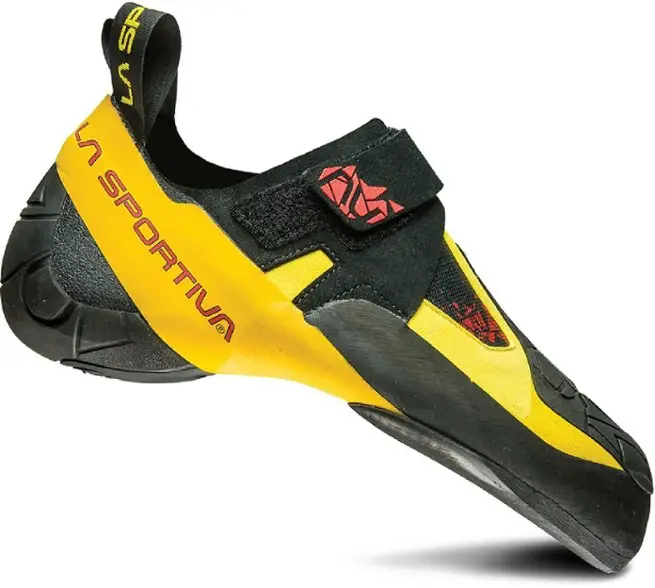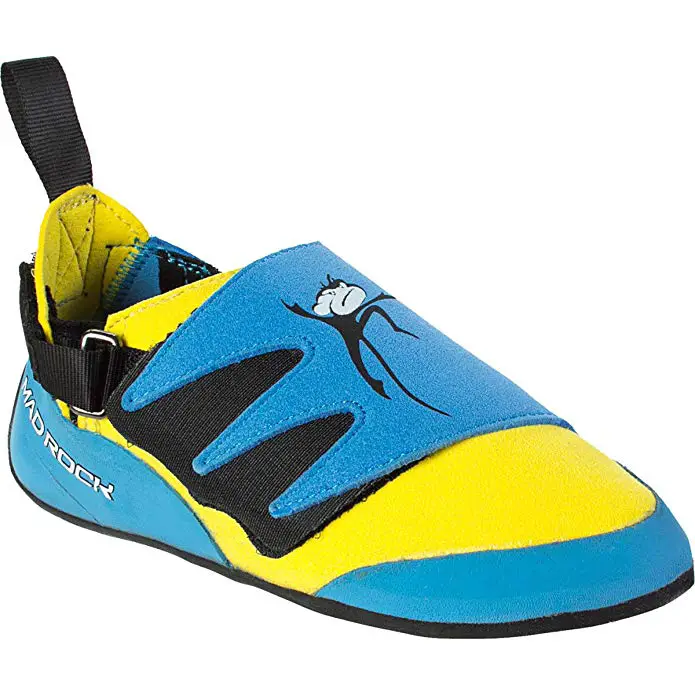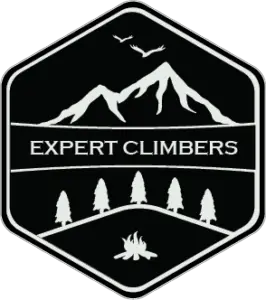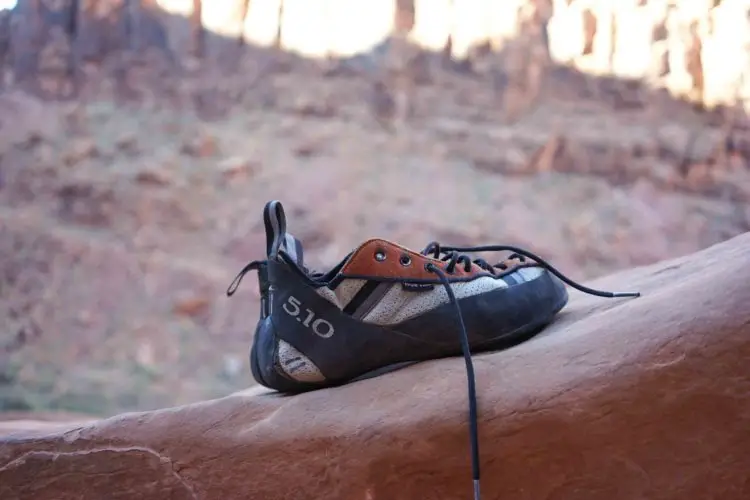You know, when I first tried out climbing, I didn’t have climbing shoes. At the local gym, we were given the option of wearing sneakers or running shoes, or we could rent climbing shoes. I have to be honest…the first time I tried climbing, I was doing it because I’d agreed to try something new with a friend. I didn’t realize I was going to fall in love with it.
The second time I went, I rented climbing shoes. And I realized how much better that made my experience. Once I found myself going there regularly though, I knew I’d better invest in my own pair. That was then. Now, I own 5 pairs of climbing shoes.
Before you find that excessive, let me stress that different climbing shoes are best for different climbs. What suffices at the gym isn’t always best on the crag.
New to climbing? Get ready to go shoe shopping! But first, here’s a whole breakdown on the different types of climbing shoes so you can decide what you need.
3 Different Climbing Shoe Types
First, I’m going to break it down by shoe types and the good and bad for each. I hope this will help you figure things out.

– Neutral climbing shoes
As a beginner, neutral climbing shoes will suit you quite well. They’re more relaxed to the fit so you can wear them all day, making them a comfortable choice for newbies and experienced climbers alike. Once you get more into climbing, if you have a pair of these, it’s highly likely that you’ll be like me and grab them for those long multi-pitch climbs. These ones from Scarpa are my favorites.
Advantages:
– They’re comfortable for all-day wear
– They usually have midsoles that are medium-to-stiff along with thick rubber soles which give you awesome support
– The flat profile is fantastic for jamming into cracks
Disadvantages:
– Those thicker and stiffer soles make the feel less sensitive
– Not good for difficult routes with overhangs

– Moderate climbing shoes
Perhaps not your best choice for your first climbing shoe, moderate climbing shoes have a slightly downturned profile, which is perfect for technical climbs. They’re very multi-purpose which is why I have my trusty Scarpa Vapor when I take on slab routes and crack climbs. They give me a stronger grip that helps me feel more secure, something you’ll really appreciate when climbing.
Advantages:
– The downturned shape gives you more power over the neutral type of climbing shoe
– Ideal for more challenging routes
– Thinner soles and stickier rubber mean they have a tougher grip you can feel
– Definitely more comfortable than aggressive shoes
Disadvantages:
– When it comes to those very overhung routes and other challenges, these aren’t as good for performance as aggressive climbing shoes
– They’re not as comfortable as neutral shoes
– They tend to wear faster than neutral climbing shoes

– Aggressive climbing shoes
Aggressive climbing shoes have the very distinguished feature of very downturned toes which helps give you lots of heel tension. La Sportiva Skwama (for those who prefer verlcro straps) La Sportiva Genius (if you prefer a lace-up climbing shoe) for example are a solid choice for those challenging climbs, especially overhanging ones. They’re asymmetric in shape, curving toward your big toe to give you that power for absolute precision on small holds. They’re very snug and are best for a single-pitch like a sport climb or for use at the gym.
Advantages:
– The shape is outstanding to get your feet into a strong position
– Better grip and feel over neutral shoes for difficult climbs
Disadvantages:
– These are much less comfortable than the other two types of climbing shoes
– That downturned shape isn’t good for fitting into cracks quite as well or smearing
– The rubber wears faster than with neutral shoes
Soft vs. Stiff Climbing Shoes
Another thing you should know before you head to amazon to get one of those climbing shoes is whether you should go for soft or stiff. Keep your mind out of the gutter… we’re talking climbing shoes here!
There’s a bit of a debate here and I remember wrestling with this issue as a newbie years ago.
Do I choose soft or stiff climbing shoes?
After talking to those more experienced than me, and now with my own experiences to add, I’m going to tell you this: you need a stiffer shoe. Trust me. It takes great power to stand right over your toes and you’re encountering small holds. The softer your climbing shoe, the less grip you’ve got.
A stiffer climbing shoe helps keep your feet from getting tired. Believe me, they will get tired and you will have no energy left to cling to those holds. Stiff shoes help you because that midsole provides you the support you need. Unless you’re climbing every day, it’s going to take you time to build foot strength. Once you have that, a softer shoe can certainly be used, but in the beginning, go stiffer.
Closure type for climbing shoes
Now, let’s get into styles, shall we? There are three designs for climbing shoe closures. Here’s the deets on each.
– Lace-up
Climbing shoes that lace up tend to be most comfortable. You can adjust the level of tightness, which is really handy. That’s why I love La Sportiva Genius because after a long day of climbing, I can loosen those babies up and instantly feel better.
I’d say my only real complaint about lace-ups is that you’ve got to take them on and off when heading to your routes, a mild inconvenience but there it is. I prefer lace-ups that get right up to the toe because they give you a really snug fit, but one thing I’ve noticed is that the laces can get in my way sometimes.
– Velcro
With Velcro, it’s really easy to put them on and take them off, making a Velcro closure ideal for bouldering or sport climbing. That makes them a bit more comfortable while also giving you the performance you need. When you first get them, they should be very snug. As they stretch, you can adjust the fit. But that’s also the downside too because if you wear them too often, they will stretch out too much. It’s best to just wear these while you’re on the rock. Scarpa Instinct VS has pretty rave reviews though I have the La Sportiva Miura VS since it caters to my needs just a bit more.
– Slip-on climbing shoes
The elastic makes it possible for you to get these on. The vacuum fit keeps it in place. You may even find some that have a Velcro closure up at the top to get the best of both worlds. These are sublimely comfortable and great for technical climbs with those tricky thin cracks, but you can use them during training and bouldering too. I’ve used mine for sport climbing. Check them out here (Five Ten Anasazi MoccAsym)!
Leather vs. synthetic climbing shoes
Now let’s talk materials. Vegans out there are most certainly heading for synthetic over leather, but please hear me out on the differences here so you can get the best climbing experience from your shoes.
First, the good thing is it’s merely a matter of preference over leather or synthetic uppers on your climbing shoes. I suggest you always try them on and figure out what you like. You can also see what other climbers you know have to say so you can merge them with my words of wisdom to get your perfect fit.
The thing is though leather stretches and synthetics do not. So, you’ll need to bear this in mind when buying your climbing shoes. The positive side of stretching for the leather is that it will conform to your foot in time, giving you that perfect fit. My Miuras I mentioned before I bought in a much smaller size. Once I broke those babies in, they fit like nothing else.
But there’s something to be said for synthetics too. The thing with them is that you should buy those in a bigger size. So, in short, leather uppers should be bought in a size smaller than you need while synthetics should be bigger. And now, there’s even better news because a lot of brands have begun making leather with a synthetic liner in the areas prone to stretching which is sheer genius, like with La Sportiva Solution. These will be my next choice when I need a new pair.
Rubber: What You Need to Know
Everyone has a different opinion on rubber and while I’m going to give you mine, I urge you to form your own opinion with experience too. You may find certain things work for you that other climbers (even me) will disagree with but if it works for you, it’s the right choice.
Rubber that tends to be stickier is often softer and lacks the durability for the long haul. And if it’s really soft and super-sticky, you’re likely going to be back out shopping for climbing shoes sooner than you expected. These tend to get scraped up pretty fast and they often lead you to slide off your holds.
On the other hand, hard rubber can hold that edge for longer but it’s not so good at sticking your foot to the rock. So for high-performance sport routes or bouldering, soft rubber generally works the best, but since you’re stating out, I recommend you get an all-day shoe that has durability to it. You can find my favorites here!
Men’s and Women’s Versions
Much of the climbing shoes for men and women look the same. The biggest difference between them is that men’s tend to be wider and women’s are narrower. But if you’re a woman with wide feet, there’s nothing that should stop you from getting a pair of men’s climbing shoes if they indeed give you a better fit. I know I said “snug” before but there’s a difference between a tight fit and crushing the bones in your feet.
Conversely, men with narrow feet shouldn’t be ashamed to go with a women’s climbing shoe if it’s a better fit for them. No one in climbing has ever once pointed at someone else and been like, “Ha!” like Nelson Muntz from The Simpsons. We don’t care about that. Besides, we’re too busy watching our lead climbers or looking out for rocks and other hazards to poke fun at your shoe selections.
There are also unisex offerings, but I’ve found them to be too generic in regards to fit. They don’t come in varying widths which makes it hard for me and my wide feet to really get the right tight fit.

Kid’s climbing shoes
Got a kiddo that loves climbing? Great! You’ll find they have climbing shoes for kids too. They’re made with rubber soles, same as yours, and they give kids a better grip for getting up there than regular sneakers. If your kid just climbs once in a blue moon, like at one of those birthday parties, I hardly see the need for them. My sister has kids and their feet grow faster than the grass on my lawn. Your kid can just use their sneakers on those random climbs.
But if your kid is interested in climbing frequently, then making the investment is absolutely worth it. Some of the manufacturers have even made it easier for you to buy kid’s climbing shoes because they’ve designed them to work with that rapid foot growth kids tend to have. They don’t have any camber in them so they won’t damage the foot. It’s worth checking out if your kid wants to climb the walls. I’ve heard great things about Mad Rock’s Mad Climbing Shoes from my friends with climbing kids.
General Rules for Fitting Climbing Shoes
Now that we’ve covered all that, here’s what to look for when you’re trying on your potential climbing shoes.
– Don’t choose shoes that leave a space between your toes and the inside of the shoe. This isn’t like your sneakers or your non-climbing shoes. You need a precise fit or else the shoe won’t stay rigid when you’ve got your toes on a hold.
– Your toes should be flat, or with curved shoes, not be bunched up painfully at the top of the shoe. Ouch!
– Heels should be snugly fit inside. Stand on your toe to make sure the back of your shoe isn’t pinching that tender Achilles tendon area, something that would make you purely miserable on any climb.
– If you have a struggle getting a climbing shoe to slip onto your foot, it’s definitely too tight.
– Higher performance shoes mean a tighter fit. Just make sure you can actually get your foot in there.
I’ve got a great post about how tight climbing shoes should be so check that out for more tips!
Conclusion On The Different Types Of Climbing Shoes
It all boils down to what you’re going to use your climbing shoes for, your preference of style, and your preference of materials. For beginners, I suggest the neutral style and you can work your way on up to a more technical shoe from there. Even when you do, that neutral shoe will be with you on your multi-pitch climbs to give you more comfort.
As you get more into climbing, you’re going to wind up with more shoes. It’s just the way it goes! But each one gives you a specific feeling for certain types of climbs and it’s important you go with the ones that give you and your feet that special feeling too.

